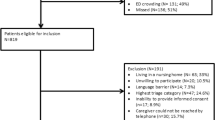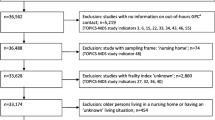Abstract
Background and aims
For older adults, an Emergency Department (ED) visit represents a period of vulnerability that extends beyond the visit itself. This study aimed to determine the impact of the role of caregiver, and geriatric conditions of patients on early unplanned rehospitalization (EUR) within 3 months after an ED visit.
Methods
This prospective longitudinal experimental study included consecutively 173 patients aged 75 and older admitted in an ED over a 2-week period (18.7 % of the total visits). Only older patients having a caregiver were analyzed (78.0 %, n = 135). Medical conditions and a comprehensive geriatric assessment were recorded for each patient. All caregivers were interviewed about their tasks and emotional impact using the short Zarit Burden Inventory. Three months after, patients or their caregivers were called about the vital status, and EUR of patients.
Results
Among the patients included, 64.2 % had an EUR and 28.9 % of their caregivers reported a high level of burden. EUR was strongly associated with a high caregiver burden (OR 8.7, 95 % CI 1.5–49.8). No association was found for patient’s medical or geriatric status. Caregivers reported a significantly high burden when patients were malnourished, or were at risk of adverse health outcomes based on the ISAR scale, and when they had greater disabilities in IADLs and ADLs, or cognitive impairments.
Conclusions
Many hospital readmissions after an ED visit may be preventable by identifying caregiver’s high burden. Reasons that lead to this high burden should be checked at the first visit.
Similar content being viewed by others
References
Soullier N, Weber A (2011) L’implication de l’entourage et des professionnels auprès des personnes âgées à domicile. Etudes et résultats. http://www.drees.sante.gouv.fr/l-implication-de-l-entourage-et-des-professionnels-aupres-des-personnes-agees-a-domicile,9279.html. Accessed 26 Feb 2014
Thomas P, Ingrand P, Lalloue F, Hazif-Thomas C, Billon R, Viéban F, Clément JP (2004) Reasons of informal caregivers for institutionalizing dementia patients previously living at home: the Pixel study. Int J Geriatr Psychiatry 19:127–135 [PubMed:14758578]
Takai M, Takahashi M, Iwamitsu Y, Ando N, Okazaki S, Nakajima K, Oishi S, Miyaoka H (2009) The experience of burnout among home caregivers of patients with dementia: relations to depression and quality of life. Arch Gerontol Geriatr 49:e1–e5. doi:10.1016/j.archger.2008.07.002
Bevans M, Sternberg EM (2012) Caregiving burden, stress, and health effects among family caregivers of adult cancer patients. JAMA 307:398–403. doi:10.1001/jama.2012.29
Visser-Meily JM, Post MW, Riphagen II, Lindeman E (2004) Measures used to assess burden among caregivers of stroke patients: a review. Clin Rehabil 18:601–623 [PubMed:15473113
McGuire DB, Grant M, Park J (2012) Palliative care and end of life: the caregiver. Nurs Outlook 60:351–356. doi:10.1016/j.outlook.2012.08.003
Garlo K, O’Leary JR, Van Ness PH, Fried TR (2010) Burden in caregivers of older adults with advanced illness. J Am Geriatr Soc 58:2315–2322. doi:10.1111/j.1532-5415.2010.03177.x
Vlachantoni A, Evandrou M, Falkingham J, Robards J (2013) Informal care, health and mortality. Maturitas 74:114–118. doi:10.1016/j.maturitas.2012.10.013
Samaras N, Chevalley T, Samaras D, Gold G (2010) Older patients in the emergency department: a review. Ann Emerg Med 56:261–269. doi:10.1016/j.annemergmed.2010.04.015
Ballabio C, Bergamaschini L, Mauri S, Baroni E, Ferretti M, Bilotta C, Vergani C (2008) A comprehensive evaluation of elderly people discharged from an Emergency Department. Intern Emerg Med 3(245–9):18. doi:10.1007/s11739-008-0151-1
Aminzadeh F, Dalziel WB (2002) Older adults in the emergency department: a systematic review of patterns of use, adverse outcomes, and effectiveness of interventions. Ann Emerg Med 39:238–247 [PubMed:11867975]
Bissett M, Cusick A, Lannin NA (2013) Functional assessments utilised in emergency departments: a systematic review. Age Ageing 42:163–172. doi:10.1093/ageing/afs187
Rutschmann OT, Chevalley T, Zumwald C, Luthy C, Vermeulen B, Sarasin FP (2005) Pitfalls in the emergency department triage of frail elderly patients without specific complaints. Swiss Med Wkly 135:145–150 [PubMed:15832233]
Lanièce I, Couturier P, Dramé M, Gavazzi G, Lehman S, Jolly D, Voisin T, Lang PO, Jovenin N, Gauvain JB, Novella JL, Saint-Jean O, Blanchard F (2008) Incidence and main factors associated with early unplanned hospital readmission among French medical inpatients aged 75 and over admitted through emergency units. Age Ageing 37:416–422. doi:10.1093/ageing/afn093
Dramé M, Lang PO, Novella JL, Narbey D, Mahmoudi R, Lanièce I, Somme D, Gauvain JB, Heitz D, Voisin T, de Wazières B, Gonthier R, Ankri J, Saint-Jean O, Jeandel C, Couturier P, Blanchard F, Jolly D (2012) Six-month outcome of elderly people hospitalized via the emergency department: the SAFES cohort. Rev Epidemiol Sante Publique 60:189–196. doi:10.1016/j.respe.2011.11.004
Gentile S, Lacroix O, Durand AC, Cretel E, Alazia M, Sambuc R, Bonin-Guillaume S (2013) Malnutrition: a highly predictive risk factor of short-term mortality in elderly presenting to the emergency department. J Nutr Health Aging 17:290–294. doi:10.1007/s12603-012-0398-0
Van Durme T, Macq J, Jeanmart C, Gobert M (2012) Tools for measuring the impact of informal caregiving of the elderly: a literature review. Int J Nurs Stud 49:490–504. doi:10.1016/j.ijnurstu.2011.10.011
Commission Nationale de l’Informatique et des Libertés (2012). http://www.cnil.fr/vos-responsabilites/declarer-un-fichier/. Accessed 31 Jan 2012
Revel Da Rocha V, Harit Chabalet I, Kervinio C et al (2002) Construction d’une échelle simplifiée pour la détection en médecine générale du fardeau de l’aidant d’une personne âgée dépendante. L’année gérontologique. vol 16, Tome 1
Zarit SH, Reever KE, Bach-Peterson J (1980) Relatives of the impaired elderly: correlates of feelings of burden. Gerontologist 20:649–655
Zarit SH, VandenBos GR (1990) Effective evaluation of memory in older persons. Hosp Community Psychiatry 41(9–10):16 [PubMed: 2403966]
Higginson IJ, Gao W, Jackson D, Murray J, Harding R (2010) Short-form Zarit Caregiver Burden Interviews were valid in advanced conditions. J Clin Epidemiol 63:535–542. doi:10.1016/j.jclinepi.2009.06.014
Parmelee PA, Thuras PD, Katz IR, Lawton MP (1995) Validation of the Cumulative Illness Rating Scale in a geriatric residential population. J Am Geriatr Soc 43:130–137 [PubMed:7836636]
Salvi F, Miller MD, Grilli A, Giorgi R, Towers AL, Morichi V, Spazzafumo L, Mancinelli L, Espinosa E, Rappelli A, Dessì-Fulgheri P (2008) A manual of guidelines to score the modified cumulative illness rating scale and its validation in acute hospitalized elderly patients. J Am Geriatr Soc 56:1926–1931. doi:10.1111/j.1532-5415.2008.01935.x
McCusker J, Bellavance F, Cardin S, Trepanier S, Verdon J, Ardman O (1999) Detection of older people at increased risk of adverse health outcomes after an emergency visit: the ISAR screening tool. J Am Geriatr Soc 47:1229–1237 [PubMed:10522957]
Kaiser MJ, Bauer JM, Ramsch C, Uter W, Guigoz Y, Cederholm T, Thomas DR, Anthony P, Charlton KE, Maggio M, Tsai AC, Grathwohl D, Vellas B, Sieber CC, MNA-International Group (2009) Validation of the Mini Nutritional Assessment short-form (MNA-SF): a practical tool for identification of nutritional status. J Nutr Health Aging 13:782–788 [PubMed: 19812868]
Clément JP, Nassif RF, Léger JM, Marchan F (1997) Development and contribution to the validation of a brief French version of the Yesavage Geriatric Depression Scale. Encephale 23:91–99 [PubMed: 9264935]
Katz S, Ford AB, Moskowitz RW, Jackson BA, Jaffe MW (1963) Studies of illness in the aged. The index of ADL: a standardized measure of biological and psychosocial function. JAMA 185:914–919 [PubMed:14044222]
Collège National des enseignants de gériatrie, Module 5 (2010) Masson, Paris
Lawton MP, Brody EM (1969) Assessment of older people: self-maintaining and instrumental activities of daily living. Gerontologist 9:179–186 [PubMed:5349366]
Covinsky KE, Newcomer R, Fox P, Wood J, Sands L, Dane K, Yaffe K (2003) Patient and caregiver characteristics associated with depression in caregivers of patients with dementia. J Gen Intern Med 18:1006–1014 [PubMed:14687259]
Lilly MB, Robinson CA, Holtzman S, Bottorff JL (2012) Can we move beyond burden and burnout to support the health and wellness of family caregivers to persons with dementia? Evidence from British Columbia, Canada. Health Soc Care Community 20:103–112. doi:10.1111/j.1365-2524.2011.01025.x
De Rotrou J, Cantegreil I, Faucounau V, Wenisch E, Chausson C, Jegou D, Grabar S, Rigaud AS (2011) Do patients diagnosed with Alzheimer’s disease benefit from a psycho-educational programme for family caregivers? A randomised controlled study. Int J Geriatr Psychiatry 26:833–842. doi:10.1002/gps.2611
Bauer M, Fitzgerald L, Haesler E, Manfrin M (2009) Hospital discharge planning for frail older people and their family. Are we delivering best practice? A review of the evidence. J Clin Nurs 18:2539–2546. doi:10.1111/j.1365-2702.2008.02685.x
Durand AC, Gentile S, Devictor B, Palazzolo S, Vignally P, Gerbeaux P, Sambuc R (2011) ED patients: how nonurgent are they? Systematic review of the emergency medicine literature. Am J Emerg Med 29:333–345. doi:10.1016/j.ajem.2010.01.003
Soullier N (2012) L’aide humaine auprès des adultes à domicile : l’implication des proches et des professionnels. Etudes et Résultats. http://www.drees.sante.gouv.fr/IMG/pdf/er827.pdf. Accessed 26 Feb 2014
Guillemin P, Gauthier AM, Bret G, Gonthier R (2014) Caractéristiques des aidants ayant à charge un proche en perte d’indépendance sévère à domicile : enquête départementale auprès de 971 aidants. Revue de Gériatrie (La) 39:497–508
Künemund H (2006) Changing Welfare States and the “Sandwich Generation”: Increasing Burden for the Next Generation? Int J Ageing Later Life 1:11–29. Accessed 15 Jan 2014
Carretero S, Garcés J, Ródenas F, Sanjosé V (2009) The informal caregiver’s burden of dependent people: theory and empirical review. Arch Gerontol Geriatr 49:74–79. doi:10.1016/j.archger.2008.05.004
Soullier N (2012) Aider un proche à domicile: la charge ressentie. Etudes et Résultats, 799. http://www.drees.sante.gouv.fr/aider-un-proche-age-a-domicile-la-charge-ressentie,10861.html. Accessed 26 February 2014
Sherwood PR, Given CW, Given BA, von Eye A (2005) Caregiver burden and depressive symptoms: analysis of common outcomes in caregivers of elderly patients. J Aging Health 17:125–147 [PubMed:15750048]
Semiatin AM, O’Connor MK (2012) The relationship between self-efficacy and positive aspects of caregiving in Alzheimer’s disease caregivers. Aging Ment Health 16:683–688. doi:10.1080/13607863.2011.651437
Kate N, Grover S, Kulhara P, Nehra R (2013) Positive aspects of caregiving and its correlates in caregivers of schizophrenia: a study from north India. East Asian Arch Psychiatry 23:45–55 [PubMed:23807629]
Garcés J, Carretero S, Ródenas F, Alemán C (2010) A review of programs to alleviate the burden of informal caregivers of dependent persons. Arch Gerontol Geriatr 50:254–259. doi:10.1016/j.archger.2009.04.012
Conflicts of interest
On behalf of all authors, the corresponding author states that there is no conflict of interest.
Ethical standards
This study involved human participants and has been approved by two national ethics committees, the Advisory Committee on Health Research Information (“Comité Consultatif sur le Traitement de l’Information en matière de Recherche dans le domaine de la Santé”) and the National Commission on Informatics and Freedom (“Commission Nationale Informatique et Liberté”) and performed in accordance with ethical standards.
Informed consent
All patients and their caregiver signed informed consent before inclusion to the procedure.
Author information
Authors and Affiliations
Corresponding author
Rights and permissions
About this article
Cite this article
Bonin-Guillaume, S., Durand, AC., Yahi, F. et al. Predictive factors for early unplanned rehospitalization of older adults after an ED visit: role of the caregiver burden. Aging Clin Exp Res 27, 883–891 (2015). https://doi.org/10.1007/s40520-015-0347-y
Received:
Accepted:
Published:
Issue Date:
DOI: https://doi.org/10.1007/s40520-015-0347-y




